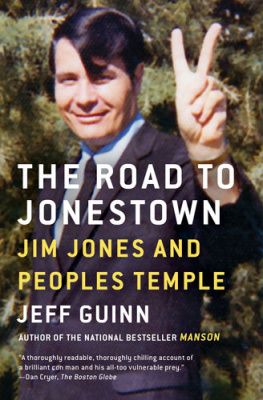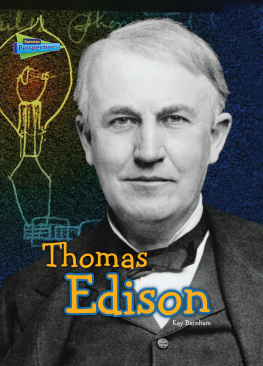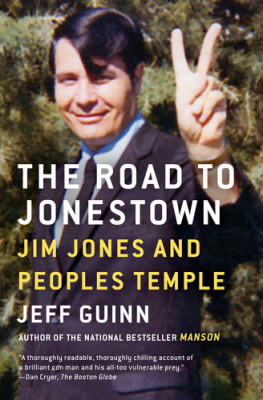Also by Jeff Guinn
The Road to Jonestown: Jim Jones and Peoples Temple
Manson: The Life and Times of Charles Manson
The Last Gunfight: The Real Story of the Shootout at the O.K. CorralAnd How It Changed the American West
Go Down Together: The True, Untold Story of Bonnie and Clyde

Simon & Schuster
1230 Avenue of the Americas
New York, NY 10020
www.SimonandSchuster.com
Copyright 2019 by 24Words LLC
All rights reserved, including the right to reproduce this book or portions thereof in any form whatsoever. For information, address Simon & Schuster Subsidiary Rights Department, 1230 Avenue of the Americas, New York, NY 10020.
First Simon & Schuster hardcover edition July 2019
SIMON & SCHUSTER and colophon are registered trademarks of Simon & Schuster, Inc.
For information about special discounts for bulk purchases, please contact Simon & Schuster Special Sales at 1-866-506-1949 or .
The Simon & Schuster Speakers Bureau can bring authors to your live event. For more information, or to book an event, contact the Simon & Schuster Speakers Bureau at 1-866-248-3049 or visit our website at www.simonspeakers.com.
Interior design by Paul Dippolito
Jacket design by Richard Hasselberger
Jacket photograph by Bettmann/Getty Images
Names: Guinn, Jeff, author.
Title: The vagabonds : the story of Henry Ford and Thomas Edisons ten-year road trip / Jeff Guinn.
Description: First Simon & Schuster hardcover edition. | New York: Simon & Schuster, 2019. | Series: Simon & Schuster nonfiction original hardcover | Includes bibliographical references and index.
Identifiers: LCCN 2018053698| ISBN 9781501159305 (hardcover) | ISBN 1501159305 (hardcover) | ISBN 9781501159329 (ebook)
Subjects: LCSH: Ford, Henry, 18631947TravelUnited States. | Edison, Thomas A. (Thomas Alva), 18471931TravelUnited States. | Automobile engineersUnited StatesBiography. | BusinessmenUnited StatesBiography. | InventorsUnited StatesBiography. | Automobile travelUnited StatesHistory20th century. | VacationsUnited StatesHistory20th century. | United StatesDescription and travel.
Classification: LCC TL 140.F6 G85 2019 | DDC 917.304/9130922dc23 LC record available at https://urldefense.proofpoint.com.
ISBN 978-1-5011-5930-5 (hardcover)
ISBN 978-1-5011-5932-9 (ebook)
For Jon Karp, who suggested the subject.
And for James Ward Lee, Carlton Stowers, Anne E. Collier, Jim Fuquay, and Ralph Lauer, the friends who were with me on many of the miles.
Prologue
Paris, Michigan
Mid-August 1923
B ad weather plagued much of Michigan during the late summer of 1923. Unseasonably cool temperatures combined with near-constant rain, trapping residents indoors and tamping down what had been, for the last fifteen years or so, an ever-increasing influx of tourists eager to enjoy the states bracing mix of sprawling woodlands, arching hills, and sparkling lakes.
This was especially true in the tiny, unincorporated township of Paris, named in the 1850s for early settler John Parish. Somewhere along the line the h was dropped. If most of Michigan eerily resembled a palm-down left hand, Paris was located at approximately the lowest joint of the ring finger. Grand Rapids, the nearest city of any consequence, was sixty-five miles to the south, several hours hard driving given the poor quality of the roads wending their way through that part of the state. Paris, like most of its neighboring villages in Mecosta County, was a stop for the Grand Rapids and Indiana Railroad to take on water and load timber and other goods after its tracks were laid across the state in the late 1860s and early 1870s. Paris residents, rarely numbering above the mid-hundreds, were mostly farmers. Others worked at the state fish hatchery in townthe wide Muskegon River flowed nearby. The hatchery was the towns crown jewel. When the train left town, it always carried containers of brown trout fingerlings to stock lakes and rivers all over the region. Many of the humble houses in town were still fairly new. A fire in 1879 had decimated much of the early settlement, and cash-strapped locals took almost a generation to completely rebuild.
Early in Pariss modest existence, outsiders usually arrived as passengers on a Sunday-only picnic train from Grand Rapids that made one of its stops near the hatchery. These visitors frequently purchased drinks, snacks, and notions at Montagues store. The Montagues were among the areas first settlers. In 1923, Charlie Montague ran the shop. To attract a new generation of customers, hed installed gas pumps out front. In only two decades, the number of automobiles in America had swelled from approximately eight thousand to about ten million. Highway 131, a bumpy dirt/gravel hybrid that frequently tore tires, chipped paint, and cracked windshields, ran through the middle of town. In Michigan as everywhere else in the country, Americans increasingly used cars for weekend or extended holiday travel as well as day-to-day work- or errand-related driving. Gypsying was an early, popular term for such outings. Participants were known as vacationists, or, if extended trips involved pitching tents at night, autocampers. Many drove through Paris on their way to somewhere more interesting, often Traverse City further to the northwest, which offered ferry services to whisk passengers and their cars to the frequently spectacular climes of Michigans Upper Peninsula across Lake Michigan.
The first full-fledged gas stations had begun springing up around the country, but most of these were located in cities or else along the nations more improved major highways. Backcountry drivers generally depended on mom-and-pop grocery pumps like those at Montagues for fuel replenishment. As out-of-town traffic through town increased, so did Charlie Montagues income from sales of gasoline and motor oil. Some Paris residents owned cars, too. Like their fellow field-tillers across the land, Mecosta County farmers initially opposed the car gypsiers, who frequently camped overnight on their land without permission and left behind mounds of trash. But the farmers eventually realized the time-saving benefit of hauling crops to market by car rather than horse-drawn wagon and joined in automobile ownership themselves. There were still a lot of horses and wagons in Paris. At about 25 cents a gallon, Charlie rarely sold more than $100 worth of gas in a busy week. Thanks to the inclement weather so far in August that restricted driving for town residents and gypsiers alike, hed lately been hard-pressed to sell that much.
This made what happened in mid-month all the more surprising. On a drizzly afternoon, Paris townsfolk were out and about, puttering in gardens, visiting on stoops with neighbors, or shopping at Montagues, when they heard the purr of powerful engines. Then out of the mist on Highway 131 there appeared from the southeast a fleet of very grand automobiles, six in all, Lincolns and Cadillacs and two other vehicles that looked like nothing anyone in Paris had seen or even imagined before, hulking squarish metal wagons clearly built for hauling bulky loads.
The impressive caravan glided to a stop outside Montagues. The drivers side doors of the passenger vehicles opened, and from them emerged strapping men outfitted in matching khaki uniforms that resembled military garb. A small crowd gathered as these uniquely dressed fellows took turns filling their cars with gasoline. The onlookers, too intimidated to ask outright, whispered among themselves: Who are these people? After a few moments, their collective gaze switched to the windows of the passenger cars, staring at the men and women who still sat inside the automobiles, keeping out of the drizzle. Then a few locals felt sufficiently emboldened to move forward, and someone blurted loudly, That guy in the back seat looks like Henry Ford!
Next page














